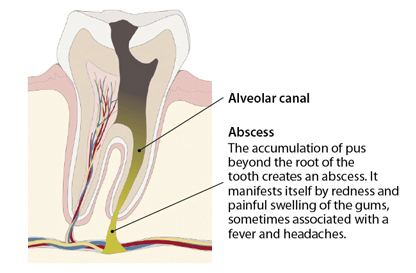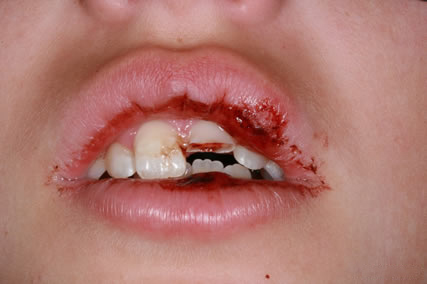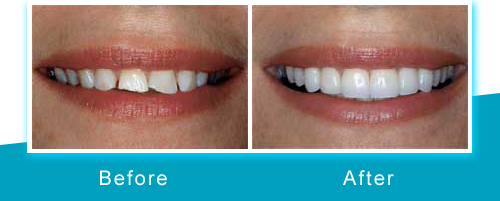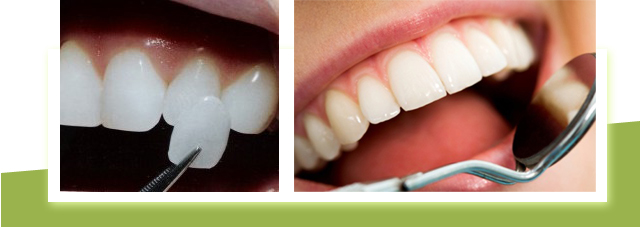


An abscessed tooth can be an extremely painful situation needing emergency dental care.
An abscessed tooth is a pocket of pus, most often caused by an infection and spread of bacteria from the root of the tooth to the tissue just below or near the tooth.
A tooth that has become abscessed is a condition where the underlying pulp (the tooth's soft core) has become infected or swollen. The pulp contains nerves, blood vessels and connective tissue, and lies within the tooth. It extends from the crown of the tooth, to the tip of the root, in the bone of the jaws.
One treatment is the use of antibiotics to kill the infection. If antibiotics are not effective and the abscess is damaging the pulp or lower bony structures of the tooth, a root canal procedure may be needed to remove the dead pulp and restore the tooth to a healthy state.

Most often, traumatic dental injuries happen to children and teenagers. However, people of all ages can experience a dental injury. These are usually caused by sports activities, car accidents, or bad falls. If you've experienced a serious dental injury, visit Dental & ENT Clinic in order to determine any necessary treatment.
Any dental injury, even if it does not seem major, should be examined by a dentist as soon as possible. Often times, neighboring teeth can experienced a unnoticed injury that can only be detected by a dental exam.
The majority of dental injuries are chipped teeth. Tooth crowns that are fractured or chipped can be repaired by a tooth-colored filling. If a large portion of the tooth crown is broken off, an artificial crown or “cap†may be needed to restore the tooth.
Injuries in the back teeth often include fractured cusps, cracked teeth, or a more serious split tooth. If cracks extend into the root, root canal treatment and a full coverage crown may be needed to restore function to the tooth. Split teeth may require extraction.
During an injury, a tooth may be pushed sideways out of place or into its socket. The tooth may need to be repositioned and stabilized. A root canal is normally necessary for dislodged permanent teeth. It is best to start the root canal procedure within a few days of the injury.
Since a young child's teeth are still developing, children between 7 and 12 years old may not require a root canal. For these patients, we will monitor the healing carefully and intervene immediately if any unfavorable developments occur.
If a tooth is completely knocked out of your mouth, time becomes critical. Handle the tooth very gently: do not touch the root surface itself. Quickly and gently rinse the tooth in water if it has gotten dirty. Put the tooth in a small cup of milk or water. Do not use soap or any other cleaning agent to wash the tooth, and never scrape or brush the tooth. If possible, place the tooth back into its socket as soon as possible. The less time the tooth is out of its socket, the better the chance for saving it.
Once the tooth has been replaced in its socket, the dentist will evaluate it and check for any other dental or facial injuries. If the tooth has not been placed back into its socket, the dentist may clean it carefully and replace it. A stabilizing splint may be placed for a few weeks. Depending on the stage of root development, your dentist may start root canal treatment a week or two later.
A serious injury to the tooth may also result in a horizontal root fracture. The location of the fracture determines the long-term health of the tooth. If the fracture is close to the root tip, the chances for success are much better. The closer the fracture is to the gum line, the poorer the long-term success rate. Stabilization with a splint is sometimes required for a period of time.
Root resorption is a condition when your body's own defense mechanisms, rejects your own tooth as a response to the dental injury. After a tooth injury, you should visit the dentist and have the tooth examined or treated at regular intervals to make certain that root resorption is not occurring and the surrounding tissues continue to heal.

If you are experiencing bleeding gums, this may be caused by a variety of reasons.
Bleeding gums are primarily a result of poor plaque removal from the teeth at the gum line. This will lead to a condition called gingivitis, or inflamed gums.
If the plaque is not removed through regular brushing, flossing, and dental cleanings, the plaque will harden into tartar. Eventually, the tartar will cause increased bleeding and a more advanced form of gum and jawbone disease known as periodontitis.
It is important to follow the guidance from your dentist to maintain healthy gums. Bad brushing and flossing technique can actually irritate or traumatize the gum tissue.

Emergency situations for braces (orthodontics) are fairly rare. The majority of problems can be solved at home. However, these situations do occur where the patient can solve the problem on their own. If this is your case, call us as soon as possible, so we can schedule a braces repair appointment.
Many patients that have braces may experience sore teeth after having braces installed. You can take non-aspirin pain relievers while you make the adjustment to the new braces. A warm cloth, heating pad or warm salt water rinses may help reduce the soreness in your jaws.
If your braces are causing irritation, try moving the wire away from the irritated area with a cotton swab or eraser. If the wire will not move, try covering the end of it with a small piece of cotton or a small amount of wax. If the wire is painful, you can cut it with nail clippers or scissors that have been washed and sterilized in alcohol.
If a loose or broken wire from your braces is irritating your mouth, cover the wire end with a small cotton ball, beeswax or a piece of gauze and then visit the dentist as soon as possible. If a wire gets stuck in your cheek, tongue or gum tissue, visit the dentist immediately.
If the main wire or a bracket comes loose, contact the dental office to find out if the bracket needs to be re-fitted. If you must cut the wire or slide a bracket off the wire, you may use fingernail clippers that have been washed and sterilized in alcohol.
If a separator comes out call the dentist to see if the separator needs to be replaced. Sometimes patients lose a separator during treatment.

If you experience a knocked out tooth, hold the tooth by the crown and rinse the root in water to clean it. DO NOT SCRUB the tooth or remove any attached tissue fragments. It is best to carefully place the tooth back into its socket if possible. Otherwise, store the tooth in a cup of milk or water and head for the dentist immediately.
If have broken a tooth, rinse your mouth with warm water to keep the area clean and apply cold compresses on your face to reduce swelling. Visit your dentist immediately.
If you are experiencing a persistent toothache, rinse your mouth with warm water, remove any food particles trapped in around your tooth by flossing, and see your dentist as soon as possible.
If you suffer a broken jaw or injury, this requires immediate attention from your dentist or the hospital emergency room. Apply cold compresses to reduce swelling.
Chipped primary (baby) teeth can be aesthetically restored. Dislodged primary teeth can, in rare cases, be repositioned. However, primary teeth that have been knocked out typically should not be replanted. This is because the replantation of a primary tooth may cause further and permanent damage to the underlying permanent tooth that is growing inside the bone.
Children's permanent teeth that are not fully developed at the time of the injury need special attention and careful follow-up, but not all of them will need root canal treatment. In an immature permanent tooth, the blood supply to the tooth and the presence of stem cells in the region may enable your dentist to stimulate continued root growth.

If your veneer or a piece of it falls off, remove it from your mouth without damaging it more. The veneer may have come off your tooth intact without breaking. If this is the case, the dentist may be able to reattach the veneer to your tooth with no problems. If the veneer is broken, the only option is to replace it with a new veneer.
Look at the shape of the veneer to evaluate whether it is the whole veneer or broke. Veneers are usually somewhat symmetrical and rounded. Also look at the tooth the veneer came off from, if there is a piece of the veneer attached to your tooth, then it is broken.
Place your veneer in a protective container, such as a cotton-filled pill box, even if the veneer is broken. Show it to your dentist as it may assist in his evaluation.
Normally no serious problems develop if your veneer falls off or is broken.
But your tooth's shape may seem rough and irritating to your lip or tongue after the veneer has broken or fallen off. A heightened sensitivity may be experienced to hot or cold foods and beverages because the veneer is gone and not protecting the tooth.
A dental crown is a tooth-shaped 'cap' that covers the tops of a damaged tooth to restore its shape and size, strengthen it, and to improve the appearance of your teeth.
Sometimes, a crown falls out or is broken. Sometimes a crown comes loose because decay has occurred underneath the crown, and the decay destroys part of the tooth and the crown doesn't have a tight seal on the tooth.
A lost crown is normally not an emergency. However, a lost crown can be very painful because the exposed tooth tissue is sensitive to temperature, pressure or air. Should you have a crown fall out, put it in a safe place and visit your dentist as soon as possible. The exposed tooth is not as strong as the crown, and it could become damaged without the protection of the crown, so get the new crown as soon as possible.
The dentist most likely will need to prepare the tooth again for a new crown to be fitted. If you still have the crown, you may be able to put it back on the tooth with dental cement from your local pharmacy. However, this is a temporary solution and you should visit your dentist to have the crown and tooth evaluated.

Fillings are a dental treatment that restores teeth damaged by decay back to their normal function and shape. When you receive a filling for a cavity, the dentist first removes the decayed tooth material, cleans the affected area, and then fills the cleaned out cavity with a filling material.
Over time, or because the filling was not done properly, some fillings may become loose, break apart, or fall out. This situation can be very painful in addition to affecting your ability to eat, drink, and function.
The treatments for a cavity or lost filling are relatively simple if you visit your dentist promptly.
In the case of a cavity, the dentist will remove the decayed portion of the tooth and replace it with a filling. Once the filling is in place, the tooth is protected, and the pain will disappear quickly.
If you have a loose filling, the dentist will remove the old filling, clean the area, and put a new filling in.
There are several reasons you may be experiencing a toothache. It could be the result of an injury to your gums or teeth, or pieces of food coming in contact with a decayed area of the tooth. Food, heat, or cold can create pressure on the nerve causing pain. If you have a lose filling or crown, the nerve inside the tooth may be exposed, causing pain.
An abscess may be the cause of your pain. This is an infection that builds up between your tooth and gum. Usually from food that is stuck between your tooth and gum for a long period. If the food particles are not removed by brushing or flossing, the pieces of food cause bacteria to multiply, and an infection develops. An abscess can be a serious health problem if it is not treated. Pain when you bite or chew can be a sign of an abscess, especially if you also notice a bad smell or a bad taste in your mouth.